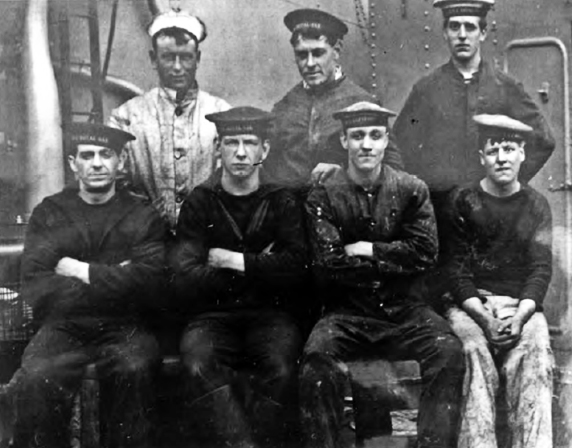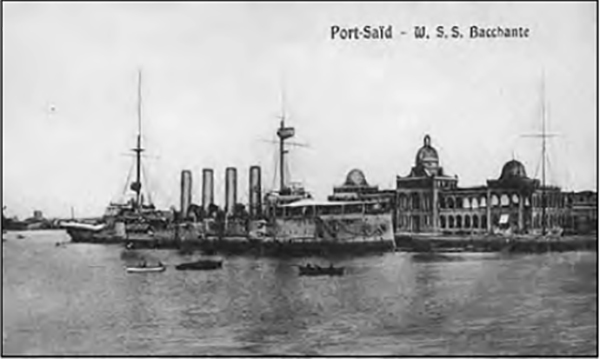- Author
- A.N. Other
- Subjects
- Biographies and personal histories, History - WW1, WWI operations
- Tags
-
- RAN Ships
- None noted.
- Publication
- March 2015 edition of the Naval Historical Review (all rights reserved)
This story first appeared in the April 2014 edition of Chatterbox, a magazine published by the Brisbane Water (NSW) Branch of Legacy and is reproduced with their kind permission.
Frank Edmond Boston was born in England in 1884 and joined the Royal Navy where he became an Able Seaman Gunner. In 1915 he was serving as a gunlayer in the forward 9.2 inch turret of the cruiser HMS Bacchante.After the war, in 1924, the Boston family migrated to Australia and Fred was to become caretaker of Rodd Island surrounded by the Parramatta River. His daughter, 94 year old Mrs Irene McIntyre, has provided the following account of her father’s experiences at Anzac Cove. Irene’s late husband Ronald also served as an Able Seaman Gunner in the RAN, mostly in the N class destroyers HMA Ships Napier and Norman,during WW II.
Outward Bound
Sometime in January 1915 we sailed from Chatham under sealed orders. Gib soon gave us an idea of our destination, which proved to be the Suez Canal, where we covered the defending troops. February found us bombarding the coast of Palestine, endeavouring to destroy the railway communications paralleling the sea. How much damage we did was never ascertained, but we did have the satisfaction of seeing one antiquated fort go up in dust.

Early in April we left our island base of Mitylene for Mudros, where we found a motley collection of ships crowding the harbour – French and British ships of war of all classes, among those the survivors of the disastrous Straits attack – and were soon joined by the transports. The Australian section of which was to be our particular care.
Arrival off Gallipoli
Midnight on Saturday 24 April and we were at sea again at action stations. Around about in the darkness were the destroyers, trawlers and transports, whose escort we were. About three in the morning our reduced speed warned us we must be creeping close to the landing place. The night was pitch dark, and the silence was deathlike. In front of us the landing – as we afterwards learnt – was proceeding, but never a sound disturbed the still as we drifted closer.
Fire Support
At about a quarter to 5 we opened fire from the forward turret, just as the first streaks of dawn were greying the turret slits. There in that cribbed, confined oval of about 10 foot diameter, fourteen of us was to spend one of the most tantalising 48 hours of our lives. We knew it – we knew we were part of it – but of the details of the happenings we were unaware. With monotonous regularity were served the 9.2 inch. Fifteen minutes firing, then the same period of rest – not to rest us but to allow the great gun to cool while her sister on the aft turret took up her work. Then it was we ate, and as time went on snatched minutes of sleep, but we never left the turret.
We were firing, of course, by direction from the control top. We could neither see our target nor observe the effects of our shots. Our nerves tingled with the repeated concussions as the 380 lb missile left the gun. Our eyes and throats tingled with the fumes, our bodies sagged with drawn-out fatigue, but most wearing was the awful uncertainty. What was happening ashore?
My brother was probably with the landing party. Several others had relatives among those cheery Australians. But on all was an unaccustomed strain. Years of training could not lift it. This was the real thing. Morning came bright and clear after the early mists. The little half-moon bay lay around us, a tiny yellow strip of sand dotted with crawling figures, moving as if on a feverish ant heap, behind the grey-green of the scrub-covered ridges. Incessantly, like an army of infuriated type-writers, pattered the sound of rife-fire. At irregular intervals a heavy burst on the beach signalled the activity of a heavy gun firing from the southern horn of the bay. Afterwards we were to know him well as Beachy Bill.
It was late in the day before the Turkish guns paid us any attention. Thereafter, as we steamed up and down on our lawful occasions, we moved among intermittent shells. They scored only one hit, a twelve-pounder, which pierced our forecastle deck and came to rest on our mess-deck – a dud.
Our shells were dropping on either side of the crest of the ridge, and not till the second day had we the satisfaction of seeing any result from our firing. Late in the afternoon a Turkish battery galloped into plain view and unlimbered on the side of the ridge. Our first shot went wide to right, but our second as a ‘bull’. Among the smoke and dirt we could see dark fragments of what had been men and horses. There was at least one gun less to fire on our ANZAC cobbers. As our eyes grew more accustomed to the scene we could see the black ant forms crawling through the scrub, ever upward, or a dark line where they were feverishly digging in. And ever, between burst of our own familiar guns, that rattling, irritating rifle-fire.
Forty-Eight Hours Later
Before our eyes the beach became yet more dotted. Stores were being stacked; a Red Cross flag flaunted defiantly over a pitifully small marquee; stranded lighters and sunken cutters showed dark against the beach’s edge, and ever the little ants moved about the crowded beach amongst the bullets and bursts of Beachy Bill. Around us buzzed the destroyers; the pinnaces, with fussy importance, puffed to and from the beach. There was surprisingly little wreckage about, and never a sign of a body, though on the beach some of the little black ants seemed never to move.
We were fated to take part in other eventful actions, to cover ill-fated Suvla Bay, to be doleful mourner at the melancholy evacuation, but none has burnt into our brains so searing a memory as our first forty-eight hours at ANZAC Cove.
The following description of HMS Bacchante has been added for the benefit of our readers.
HMS Bacchante
The Cressys were a class of six large armoured cruisers – Aboukir, Bacchante, Cressy, Euryalus and Hogue. Bacchante was launched from John Brown’s Clydeside Yard in 1901. These ships were armed with 2 x 9.2 inch guns, 12 x 6 inch and considerable secondary armament plus 2 x 18 inch torpedo tubes. They each had a complement of about 750 men.
Bacchantewas flagship of Cruiser Force ‘C’ during the August 1914 Battle of Heligoland Bight. Afterwards she escorted a convoy to Gibraltar and proceeded to Suez before making for the Dardanelles where she provided covering fire during the landing at Anzac Cove. Later when Allied infantry came under fire from Turkish artillery at Gaba Tepe, she approached close to shore and fired directly on the enemy gun emplacements with considerable effect. She returned to home waters later in 1916 and in February 1917 was damaged in collision with HMS Achilles. Bacchante completed her war-time service as flagship of the 9th Cruiser Squadron based at Gibraltar.

Unfortunately the name Cressy became infamous in Royal Naval history. The cause happened just after dawn on 22 September 1914 when three of the Cressy class cruisers were on patrol in the North Sea. The lead ship HMS Aboukir suddenly was stopped by a huge explosion and immediately began to sink, it was assumed that she had struck a mine and her sisters HM Ships Cressy and Hogue came to her aid only to suffer the same fate. All three ships were sunk by torpedoes fired by the submarine U‑9 with the loss of 1,459 officers and men. This was the worst single maritime disaster suffered by the Royal Navy during WW I; conversely it was the greatest victory by a German submarine, with U-9’s commanding officer, Kapitanleutnant Otto Weddigen, becoming a national hero.




